In March of this year, Gucci began selling a $4,500 purse in the shape of Mickey Mouse’s head. Between the creature’s round black ears is a small handle embossed with the word “Gucci.” On the brand’s website, a male model stares intensely into the camera without the slightest trace of irony that he is, in fact, toting around the disembodied head of a children’s cartoon character.

Part of this recent glut of Mickey products has to do with the fact that the character turned 90 years old last year. The Walt Disney Company, along with the many other brands that license Disney characters, sees anniversaries as an opportunity to sell even more Mickey paraphernalia than usual. According to the Wall Street Journal, Mickey Mouse and his gang (including Minnie, Goofy, Pluto, and Donald Duck) sold $3 billion in merchandise in 2018, a figure that includes both adult and children’s products. Shockingly, that is only about half of what Mickey made in 2004, when Disney heavily pushed out products in celebration of his 75th birthday.
All of this prompts the question: Why would adults wear items splashed with the face of a smiling rodent in the first place? What accounts for the enduring appeal of this anthropomorphized mouse, while other popular characters, like Ariel from The Little Mermaid, or Anna from Frozen, hardly ever appear in adult products?
The answer to the question has everything to do with the fact that Disney carefully orchestrated Mickey Mouse’s transformation from a cartoon character to a symbol. Disney ensured that Mickey could morph into almost anything the consumer needed him to be, from an emblem of hope in wartimes to a happy reminder of childhood when adulthood became overwhelming.
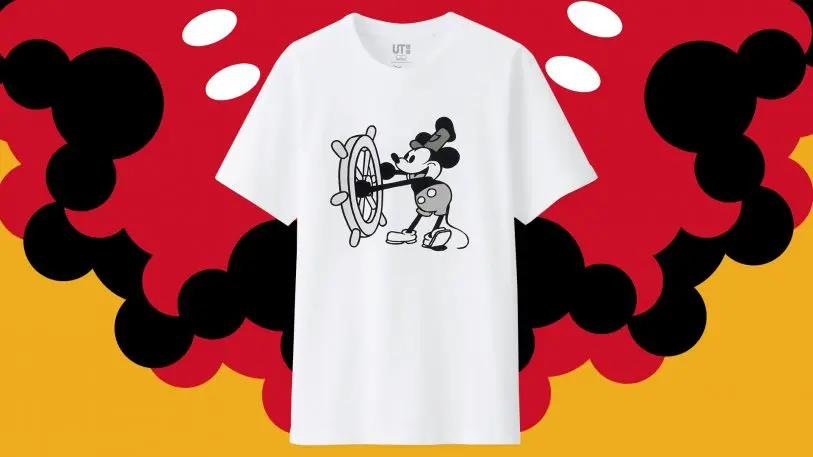
Mickey: Disney’s Best Salesman
Mickey Mouse was big business almost as soon as he made his debut in Walt Disney’s animated short Steamboat Willie in 1928. Within five years, Mickey was raking in $1 million a year in merchandise sales (equivalent to $19 million in 2019 dollars). Garry Apgar, a Yale-educated art historian who has devoted years to studying cultural representations of Mickey Mouse, tells me that in the early years, these products were largely targeted at children, and included stuffed toys, trains, and nursery wallpaper.
Everything changed in the years after World War II, Apgar says. At that point, demand for products bearing Mickey’s face among adults spiked. For one thing, Mickey was nearly two decades old, which meant that the first audience that enjoyed the cartoons as children were now in their 30s and 40s. But Disney was also willing to transform Mickey into a symbol of innocence, and Americanness during the war and in the postwar years, when people were desperate for something hopeful to cling to.
All the marketing worked. A 1947 New York Times article explained that products featuring Disney characters generated $100 million in revenue in merchandise for children and adults. At the time, Disney had already created Snow White, Pinocchio, Dumbo, and Bambi, but “Mickey is the best salesman of the lot,” the Times’ reporter wrote. In addition to kids’ products, like dolls and cereal boxes, many of the items sold were for adults, including radios, phonographs, and hot-water bottles. A total of 600,000 Mickey Mouse watches, which came in both kid and adult sizes, were sold that year alone.
By 2004, Mickey had made it to Forbes annual list of “fictional billionaires,” which identifies the bankability of characters from novels, movies, TV, and games. (Others on the list that year included Frodo Baggins, from The Lord of the Rings, and Spiderman.) “It’s not just kids who love Mickey,” the article read, pointing out that the mouse’s impressive earnings in recent years had been driven in part by a surge in adult apparel. In the words of Kay Kamen, Walt Disney’s very first licensing agent, who spoke to the Times in 1947: “No doubt of it. Mickey Mouse is the greatest thing in the history of merchandising.”
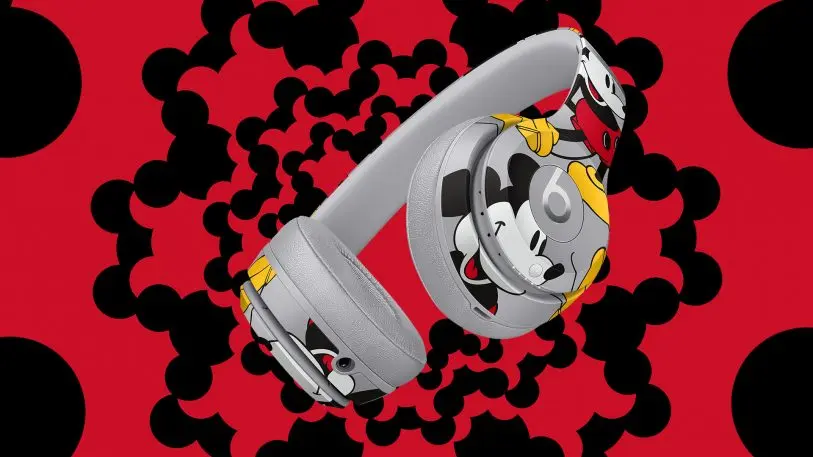
You Can’t Look Away From The Mouse
It’s no accident that adults like Mickey Mouse: Walt Disney made sure that it was nearly impossible not to.
Over the course of Mickey Mouse’s first two decades, Disney kept tweaking the character to make him more and more universally appealing. He made Mickey’s face and body rounder and more childlike. Mickey’s eyes became larger and rounder, like those of a baby. This is something that the Harvard evolutionary biologist Stephen Jay Gould observed and described as “neoteny,” which refers to the retention of juvenile features in adult animals.
Why was this effective at getting adults’ attention? Scientists have shown that adults are more drawn to childlike faces, and our eyes tend to linger on images of babies. That look is also more likely to subliminally trigger a greater level of attachment in the viewer, Gould said.
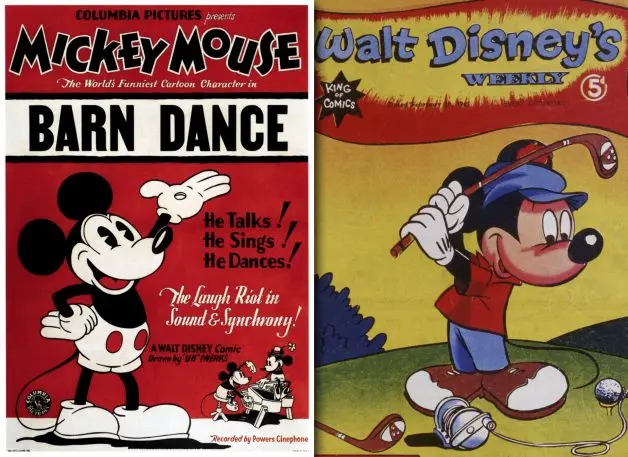
The first iterations of Mickey that Disney created looked more like an animal. “The original Mickey was rattier and leaner,” says Apgar. “He had clawed feet.” He also engaged in rougher, unwholesome behavior, including smoking, drinking, and cavorting. Consider his behavior in his second short film, called Gallopin’ Gaucho: Mickey goes to a bar where Minnie is a barmaid. When another customer, Pete, flirts with Minnie, then attempts to kidnap her, Mickey fights him in sword duel. Then, Mickey covers Pete’s head in a chamber pot.
In the next few decades, Disney revised Mickey to make him more appropriate for children. He had a mellow personality and acquired all the trappings of middle-class life: a house, a spouse, a car. He was, in fact, rather bland. But we couldn’t stop looking at him. Disney had found a way to create a character that would instantly–and subconsciously–draw viewers in, and hold their attention through his odd childlikeness.
Mickey wasn’t the only character that assumed these contours. In Disney’s other early movies, Dumbo, the seven dwarves, and Pinocchio were all exceedingly round and baby-like. Disney Studios has continued to make characters in this mold decades after Walt Disney passed away in 1966. Consider Anna and Elsa from Frozen, and Rapunzel from Tangled: They have faces that are disproportionately round, with large, expressive eyes.
But few have had the enduring appeal of Mickey Mouse. And that’s because Disney very deliberately worked to transform Mickey from a character into a globally identifiable brand.
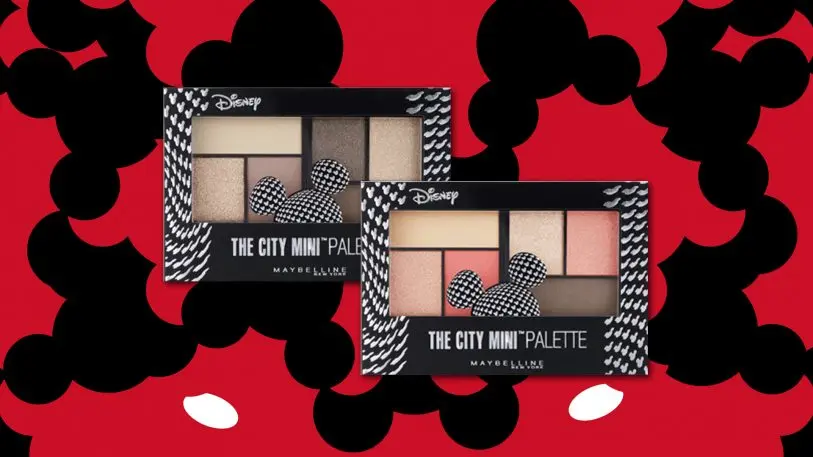
Appropriate Mickey For Whatever You Want
Mickey gave Disney the perfect vehicle for playing into consumers’ nostalgia and their desire for a safer, more innocent time. The process began to unfold during the Second World War. The soldiers going off to fight had grown up with Mickey Mouse, and they found him comforting. In 1939, Disney received a request from an air squadron on the USS Wasp to draw some cartoons on the aircraft to lift the men’s spirits.
From then on, Disney actively worked to ensure that Mickey Mouse, along with other Disney figures, was woven into the war efforts. Munitions factory workers wore buttons with Mickey on them. The United States Treasury printed Mickey on bond certificates during War Loan Drives. In one poster, Mickey is dressed in the uniform of the Aircraft Warning Service, a volunteer civilian organization created to catch early signs of an enemy attack. One of Mickey’s hands is on a telephone and the other is carrying a telescope. The poster reads, “Thousands of Eyes in the Dark: Keep Your Eyes Open.” It’s a terrifying message, and yet there Mickey appears, dripping in cuteness. The character was so tied to war efforts that the name “Mickey Mouse” was a password for an important high-level briefing about a week before D-Day, at a British naval base on the English Channel.
The genius of that approach is clear today: It makes it easy for anyone to appropriate Mickey for their own purposes, making him a symbol of whatever they want. During the Cold War, people in Eastern Europe used Mickey Mouse as a symbol of capitalism, Apgar says. (This was either a positive or negative message, depending on where you stood on Communism.) The term Mickey Mouse has also been used as a put-down, to describe something as amateurish, trivial, or worthless, such as “Mickey Mouse organization” or “Mickey Mouse degree.”
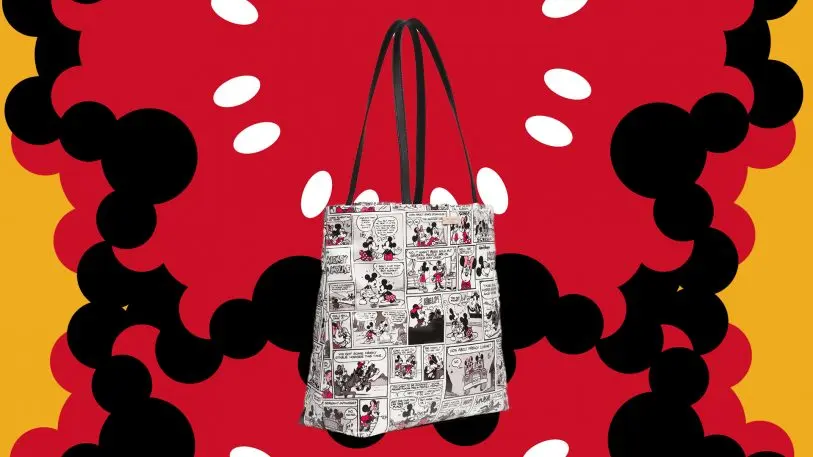
Controlling The Mickey Message
In places where Walt Disney himself had control of the narrative, he made every effort to connect Mickey with ideas of childhood, goodness, and hope. Consider the very first image of Mickey you see when you enter a Disney park. As you go past the turnstile, there is an enormous bed of flowers made in the shape of Mickey’s head. “He’s a seraphic figure,” Apgar says.
Disney’s goal was clearly to make the character universally known and loved. According to market research, Mickey Mouse has a 97% name recognition in the United States, which is even higher than Santa Claus. This is at least in part because hundreds, if not thousands, of brands around the world license Mickey’s image, making it ubiquitous.
While the Disney Company has control over Mickey’s image in its own channels–like its stores and parks–it also tries to exert control over how brands portray Mickey when they license his face. To officially use Mickey Mouse’s image, a brand must go through Disney’s lawyers and consumer products division. In conversations with three people who have done this, who prefer to remain unnamed since they want to continue working with Disney, they say that the company is extremely sensitive about any negative portrayals of Mickey Mouse. For instance, Disney has done everything in its power to ensure that brands do not use early images of Mickey drinking and smoking. (We reached out to Disney to ask how many brands license Mickey and explain its licensing process, but the company has not responded.)
But Disney can only wield so much power, particularly when it comes to adult products. On the one hand, brands like Uniqlo are simply tapping into nostalgia with simple T-shirts bearing Mickey’s face–something that most people have either seen, or owned, as children. On the other hand, there’s Gucci. Alessandro Michele, Gucci’s creative director, incorporated the Mickey Mouse bag into his aesthetic, which tends toward the eccentric, bizarre, and occasionally terrifying. In the fall/winter 2018 show in Milan, models walked down the catwalk with what appeared to be their own severed heads. In this context, the Mickey Mouse head feels a little dark and satirical. For all Disney’s careful choreography, fashion can still appropriate Mickey for its own purposes, as fashion is wont to do.
By and large, though, the symbolism Mickey embodies is the one Disney has put forth: that of positivity and innocence. This is perhaps why adults seem drawn to him during times of trouble. In World War II, people used Mickey to help cope with the horrors before them. One gas mask was printed with Mickey’s face on it to seem less threatening. This might also help explain why Mickey Mouse has been popular over the past few years when many people are experiencing angst due to unfolding geopolitical instability. These days, if we’re feeling scared about the prospect of nuclear war or climate apocalypse, we can purchase an adult-sized weighted Mickey Mouse blanket, designed by doctors, to help us sleep at night.
Recognize your brand’s excellence by applying to this year’s Brands That Matter Awards before the early-rate deadline, May 3.